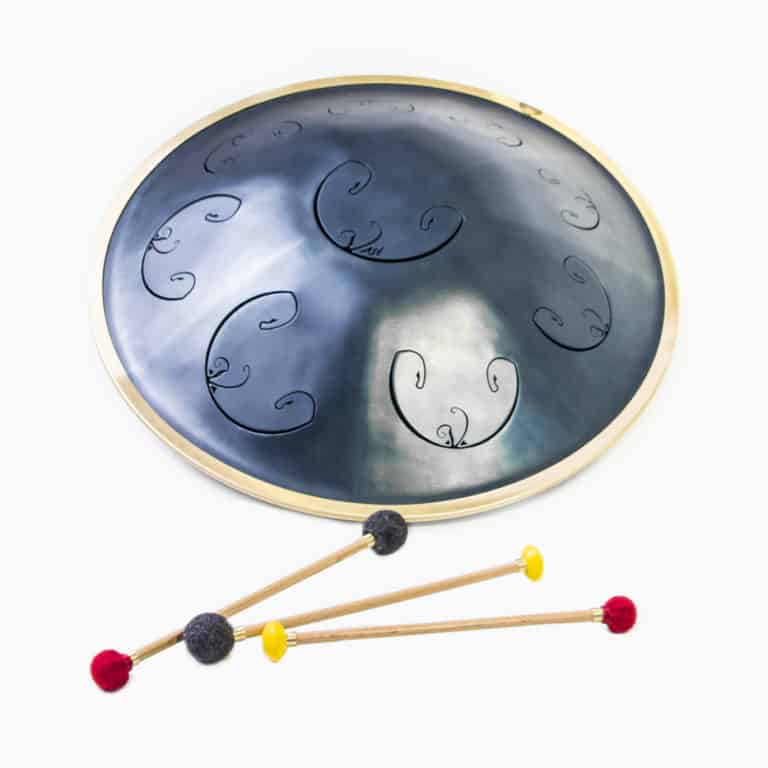Rav Vast vs Handpan Comparison (I bought a new Rav!)
You are almost certainly here because you have searched for a comparison between a Rav vast Drum and a Handpan. You may have been looking for Tongue Drum vs Handpan, but for that, you need to look at the dedicated guide on the link, which is more general and has the Rav included in the Tongue Drum category.
For this comparison, I’m looking only at The Rav Drum vs Handpan and ignoring other tongue drums. You’ll not be disappointed, there are still a lot of differences and I am going to show and explain them all.
Before we dig really deep into the differences and watch a video comparing the two instruments, albeit in 2 different scales, let’s take a look at the overview
Rav Vast vs Handpan Comparison Chart
| Elements | Rav Vast | Handpan (General) |
|---|---|---|
| Price | $650-830 | $1500+ |
| Weight | 4.9-5.9kg | Around 5kg |
| Steel Thickness | 1.5-2mm | 1-1.2mm |
| Notes | 9 or 10 | up to 24 |
| Scales | 18 | Unlimited |
| Sustain | >25secs | 5-8secs |
| Overtones | 3-7 | 4 |
| Durability | Very | Fragile |
| Needs retuning | No | Every 1-2years |
This Handpan vs Rav Vast Comparison has just made me buy a new Rav Vast.
Literally me when i finished writing this!
At the time of writing this article and checking all the data and comparisons to make sure they are up to date, I have a handpan on order. But so compelling is the Rav vast, I just have to put an order in for a new scale which will fill the gap for something new whilst I wait for the build of my new handpan.
The short waiting time for a new instrument when buying a Rav Vast is a key positive if you are impatient like me.
Price Comparison
- Rav Vast between $650-$800
- Handpan Upwards of $2000***
One hugely important factor in choosing between a Rav vast and Handpan is your budget. With a Rav Vast coming out at no more than $850 right now, all things considered, you are receiving great value for money.
Get 5% discount off your Next Rav Vast
The instruments are very comparable in terms of quality, but you will need to pay in excess of $2000 for the very best quality handpan.
***There are handpans available under this price which remain good quality instruments, but you have to know what you are looking for and where. You should not consider buying a handpan for less than $1000 at the current time. You would most likely end up very disappointed.
With Rav vast, there is only one option, it is arguably the best quality and most impressive tongue pan on the market and can’t be beaten. You will be buying just about the most expensive tongue instrument available but will be receiving every cent of your investment back, in the build quality, sound quality, durability, and longevity of your instrument.
Waiting Time
- Rav Vast 1-4 Weeks
- Handpan up to 9 months
Whilst the waiting time on some handpans has come down in recent years, for a bespoke model, and for many ‘ordinary orders’, because you get the options to choose your scale, you will be required to wait for your handpan to be made. You may not be even first in line.
I recently ordered a handpan in the full knowledge that I would have at least a 9-month wait.
There are some manufacturers who will make a run of the most popular scales during quiet ordering periods and offer them off the shelf at cheaper prices, but it is hit and miss as to whether you will get the handpan scale you are looking for.
The waiting time for a Ra vast on the other hand can be just a few days if you are lucky. If you are in Europe and you are buying from stock you could be in possession within a few days. In the US, add a few more on for the extra shipping distance.
With a staff of over 70 in Perm, Russia [Rav vast’s Base], bespoke orders can be created in 7-14 days and another week for shipping – It is quite possible you would never have to wait for more than a month even in the busiest of times.
Scales Availability
- Rav Vast 18 Almost 19 [September 2020]
- Handpan – Way more!
Way more is not a great answer, but with only a single producer of Rav vast going up against over 100 manufacturers of handpans, there is no competition here. Handpans win this category hands down.
Number of Notes
- Rav Vast – 9-10
- Handpan up to 24 (that I have heard of)
The Rav Vast has generally 8 notes and a Ding to provide a total of 9. There is a double ding option that pushes the total to ten, and I am sure there is another scale that includes an additional note too [Check the entire range of scales with videos here].
By contrast, Handpans have been developed to include anything up to and including 24 tone fields on the instrument. I have as we speak a 16 Note extended E Kurd instrument on order. The largest number of notes on a handpan or Tongue drum I will ever have had.
Handpans have developed over time and this number of notes would have been unthinkable at a time. Perhaps as the development of Rav Vast continues, there may be a way to discover a method for additional notes to be added.
There are certainly two-sided steel tongue drums out there from the likes of Kosmosky and Kindred Spirit drums in Canada, where you can play one scale on one side and another on the flip.
Overtones
- Rav Vast 3-7
- Handpan 4
When talking about overtones in reference to this comparison between a Rav Vast steel tongue drum and a handpan, I am talking about those apparent on a single note, tongue or tone field.
Depending on the scale you choose on the Rav Vast you may have anything up to 7 whereas with the Handpan you will find generally a constant 4 overtones per tone field.
What are Overtones?
An overtone in terms of what we are comparing in this example refers to the additional sounds that can be achieved from a single tongue or note on a handpan or Rav vast drum. These can be heard but also isolated by using special playing techniques.
By exploration, a little knowledge, and development of your playing technique, any concerns about a Rav vast and just 9 tongues limiting your melodic options can be thrown in the trash. An ability to find, isolate and play these overtones as a complement to the basic scale will take you to new worlds of playing
Sustain
- Rav Vast up to 25 seconds
- Handpan 5-8 seconds
The sustain is the length of time a note rings out after it has been struck or played. A great example of this is the video below where the Rav Vast is played alongside the handpan, and you can hear very clearly how the Rav notes ring out for much longer than the handpan
Weight Comparison
- Rav Vast 4.9-5.9kg
- Handpan around 5kg
There is little difference in weight between the original Rav vast at 4.9kg and the majority of handpans which weight in around the same weight.
The Rav vast 2 comes in a kilogram heavier, thanks to the thicker steel.
Strangely, in the hand, even an original Rav versus a handpan, the Rav feels heavier. This is more to do with the greater thickness of steel and the sturdier feel.
Indeed, the Rav is more sturdy and has greater durability than the handpan and that is covered below.
Steel Thickness
- Rav Vast 1.5 or 2mm
- Handpan 1mm-1.2mm
The nature of the construction of each instrument and tuning requirements determine the thickness of the steel used in creating them. The thickness does not make one better than the other, but it plays a part in the overall sound of the instrument, and the techniques used to create them.
Durability
- Rav Vast – Very Durable
- Handpan – Fragile
There is no doubt that a Rav vast tongue pan is a far more sturdy and durable instrument than the more fragile handpan.
Things that we can safely say contribute to this opinion, is that, you could drop each instrument and there is infinitely more chance that you will do some long term damage to your handpan, whilst the Rav Vast will be entirely unaffected {At this point I should point out the obvious and do not encourage you to drop any instrument to test this theory out]
The fact is the Ravs construction naturally creates a harder wearing body, with thicker steel than the handpan. The latter can also be affected by direct sun, heat, and humidity, whilst again the Rav is far less susceptible to these factors.
To this end, this is reflected in the need for tuning each of the instruments
Regular Tuning
- Rav Vast – No
- Handpan – potentially every 1-2 years
The caveat here is that the handpan could last a great deal longer before requiring a retune than the Rav vast which is unlikely to ever require being sent to Russia to be rectified.
There are a number of things that can happen to a handpan to detune it. Literally amount of play, the strength of play, heat, or knocks.
Unless you play your Rav vast with a hammer it is unlikely you ill ever need to send it away to be retuned.
Rav Vast vs Handpan Summary
This comparison between a Rav Vast Steel Tongue Drum and a traditional handpan has been done for information purposes only, not to decipher if one is better than the other.
However, it does serve a purpose in perhaps helping you decide if you would prefer to purchase a Rav vast or buy a handpan instead.
As mentioned at the head of the article, I’ve actually reminded myself and talked myself into buying a new Rav Vast whilst waiting for my 16 note handpan to be built, because of all the positive aspects I uncovered whilst conducting the direct comparisons
I hope this guide has helped. If you too want to investigate more about the Rav Vast Steel Tongue pan then you can get a 5% discount on this link.
Happy playing!


![Best Stand For A Rav Vast Steel Tongue Drum [3 Choices]](https://cdn-0.coolpercussion.com/wp-content/uploads/2020/03/handpan-stand-rav-vast.jpg)
